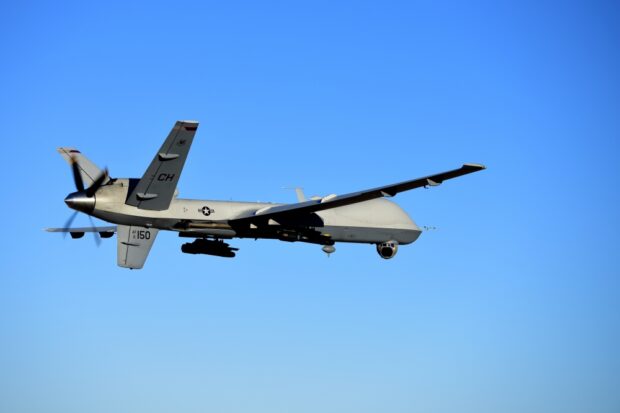Houthi rebels claim to have shot down an MQ-9 drone over Yemen on April 25, releasing nighttime intercept footage and daytime video of what appears to be MQ-9 wreckage. If confirmed, it would mark the third MQ-9 shot down by the Houthis in the past six months and the the sixth Reaper damaged in various Middle East conflicts within the 13 months.
The nighttime footage shows what appears to be the launch of a surface-to-air missile, followed by an explosion and falling wreckage. The daytime footage shows the aftermath: the apparent remains of an MQ-9 tail section, propellers and engine, and portions of a wing. Some of the parts are labeled “General Atomics.” A Houthi spokesman did not say what kind of surface-to-air missile was used in the attack.
A Pentagon spokesperson acknowledged that an MQ-9 went down in Yemen but said the crash is under investigation.
Since Hamas militants attacked Israel on Oct. 7, sparking a regional crisis, the Houthis and other Iran-backed militias have repeatedly attacked U.S. forces and commercial shipping in the Red Sea.
All told, the Houthis have threatened or attacked more than 100 commercial vessels in the waters off Yemen, saying the attacks, which have killed two merchant sailors, are showing solidarity with Gaza, where Israel has been prosecuting a retaliatory war against Hamas. They have also fired on U.S. intelligence, surveillance and reconnaissance assets, to include Reapers, operating in the region of Yemen.
- In November 2023, the Houthis shot down an MQ-9 off the coast of Yemen
- In January 2024, an MQ-9 crashed in Iraq, believed to have been shot down by the Islamic Resistance in Iraq, a group of Iranian-backed Iraqi Shia militias. The Pentagon said the missile used was likely provided by Iran.
- In February 2024, Houthis shot down an MQ-9 over the Red Sea, again using weaponry provided by Iran.
- In the latest incident in April 2024, Houthis claim to have shot down a Reaper operating over Yemen.
Before the Oct. 7 conflict began, a Russian fighter collided with an MQ-9 in March 2023 while intercepting it over the Black Sea, causing the Reaper to crash. In July 2023, Russian fighters interfered with two MQ-9s over Syria over the course of several days. They dropped flares in the path of the Reapers; damaging but not destroying them.
The U.S. and Britain have launched four joint airstrikes at Houthi targets in Yemen associated with the attacks on commercial shipping.
The Reaper has been operational since 2008. With a persistence of up to 24 hours and a ceiling of 50,000 feet, the Reaper has been valuable in ISR missions in a number of conflicts and saw heavy use in Afghanistan, Iraq and Syria. The Air Force has employed more than 320 Reapers operationally. The remotely-piloted aircraft, valued at about $30 million apiece, are operated by a rated pilot and sensor systems operator. The type is headquartered at Creech Air Force Base, Nev.
The Air Force has stopped buying the MQ-9, saying that while the type was useful in conflicts where the threat was minimal, the non-stealthy aircraft is not survivable in theaters where the opposition possesses even moderately sophisticated anti-air capabilities. The service has been intermittently pursuing an “MQ-X” replacement for a number of years, but plans to keep the MQ-9s for use in low-threat operations through 2035.
Photo: An MQ-9 Reaper flies a training mission over the Nevada Test and Training Range, July 15, 2019. U.S. Air Force photo by Airman 1st Class William Rio Rosado
Source: Air & Space Forces Magazine

